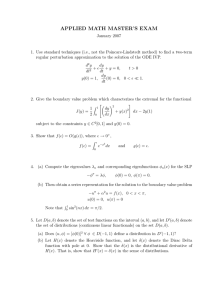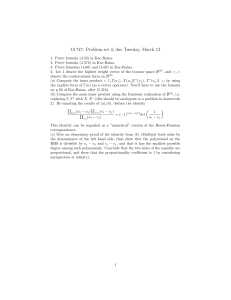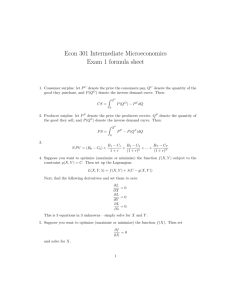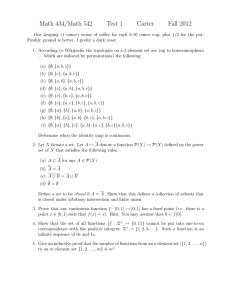Math 5010-1, Spring 2005 Assignment 2 Problems | S
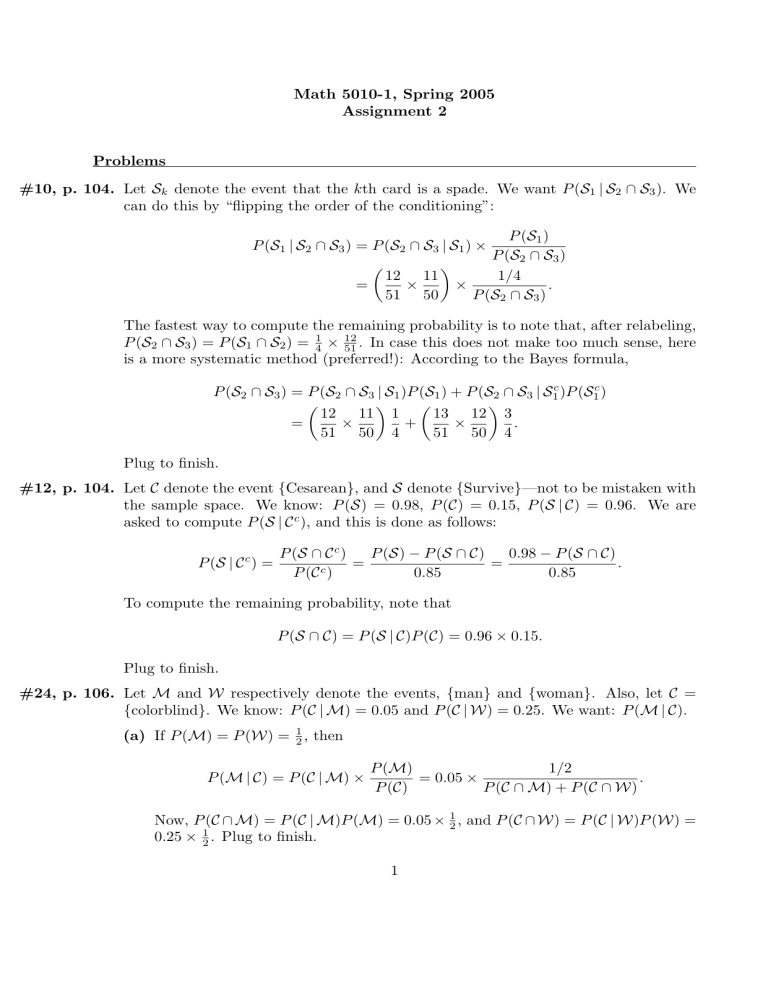
Math 5010-1, Spring 2005
Assignment 2
Problems
#10, p. 104.
Let S k denote the event that the k th card is a spade. We want can do this by “flipping the order of the conditioning”:
P ( S
1
| S
2
∩ S
3
). We
P ( S
1
| S
2
∩ S
3
) = P ( S
2
∩ S
3
| S
1
) ×
P ( S
1
)
P ( S
2
∩ S
3
)
=
12
51
×
11
50
×
P ( S
1 / 4
2
∩ S
3
)
.
The fastest way to compute the remaining probability is to note that, after relabeling,
P ( S
2
∩ S
3
) = P ( S
1
∩ S
2
) =
1 × 12
. In case this does not make too much sense, here
4 51 is a more systematic method (preferred!): According to the Bayes formula,
P ( S
2
∩ S
3
) = P ( S
2
∩ S
3
| S
1
) P ( S
1
) + P ( S
2
∩ S
3
| S c
1
) P ( S c
1
)
=
12
51
×
11
50
1
4
+
13
51
×
12
50
3
4
.
Plug to finish.
#12, p. 104.
Let C denote the event { Cesarean } , and S denote { Survive } —not to be mistaken with the sample space. We know: P ( S ) = 0 .
98, P ( C ) = 0 .
15, P ( S | C ) = 0 .
96. We are asked to compute P ( S | C c
), and this is done as follows:
P ( S | C c
) =
P ( S ∩ C c
)
P ( C c )
=
P ( S ) − P ( S ∩ C )
0 .
85
=
0 .
98 − P ( S ∩ C )
.
0 .
85
To compute the remaining probability, note that
P ( S ∩ C ) = P ( S | C ) P ( C ) = 0 .
96 × 0 .
15 .
Plug to finish.
#24, p. 106.
Let M and W respectively denote the events, { man } and { woman } . Also, let C =
{ colorblind } . We know: P ( C | M ) = 0 .
05 and P ( C | W ) = 0 .
25. We want: P ( M | C ).
(a) If P ( M ) = P ( W ) =
1
2
, then
P ( M | C ) = P ( C | M ) ×
P ( M )
P ( C )
= 0 .
05 ×
1 / 2
P ( C ∩ M ) + P ( C ∩ W )
.
Now, P ( C ∩ M ) = P ( C | M ) P ( M ) = 0 .
05 ×
0 .
25 ×
1
2
. Plug to finish.
1
2
, and P ( C ∩ W ) = P ( C | W ) P ( W ) =
1
(b) Here, P ( M ) =
2
3 and P ( W ) =
1
3
. Now plug these new values to finish.
#62, p. 111.
Let C i denote the event that the i th relay component is switched on.
(a) Current goes from A to B if and only if the following event occurs: C
5
C
2
) ∪ ( C
3
∩ C
4
) } . By independence,
∩ { ( C
1
∩
P { circuit functions } = p
5
× P ( {C
1
∩ C
2
} ∪ {C
3
∩ C
3
} )
= p
5
× { P ( C
1
∩ C
2
) + P ( C
3
∩ C
4
) − P ( C
1
∩ C
2
∩ C
3
∩ C
4
) }
= p
5
× { p
1 p
2
+ p
3 p
4
− p
1 p
2 p
3 p
4
} .
(b) Let O denote the event that the current goes through OK. Then
P ( O ) = P ( O ∩ C
3
) + P ( O ∩ C c
3
) .
We can compute the two probabilities separately.
P ( O ∩ C
3
) = P C
3
∩ C
1
∪ C
2
∩ C
4
∪ C
5
= p
3
× P C
1
∪ C
2
P C
4
∪ C
5
= p
3
× p
1
+ p
2
− p
1 p
2
× p
4
+ p
5
− p
4 p
5
.
Similarly,
P ( O ∩ C
3 c
) = P C c
3
∩ h
C
1
∩ C
4
∪ C
2
∩ C
5 i
!
= (1 − p
3
) × h
P ( C
1
∩ C
4
) + P ( C
2
∩ C
5
) − P ( C
1
∩ C
4
∩ C
2
∩ C
5
) i
= (1 − p
3
) h p
1 p
4
+ p
2 p
5
− p
1 p
2 p
4 p
5 i
.
Compile and plug to finish.
Theoretical Exercises
#6, p. 116.
First check that the complement of E
1 that
∪ · · · ∪ E n is E c
1
∩ · · · ∩
P ( E
1
∪ · · · ∪ E n
) = 1 − P h
E
1
∪ · · · ∪ E n i c
!
E c n
. This shows then
= 1 − P ( E c
1
∩ · · · ∩ E c n
)
= 1 − n
Y
P ( E i c
) = 1 − n
Y h
1 − P ( E i
) i i =1 i =1 by independence.
2
#15, p. 117.
Let S
1 be the event that the first trial leads to a success. Then,
P n
= P ( S
1
∩ { even # of successes } ) + P ( S
1 c
∩ { even # of successes } )
= pP (events 2 through n lead to an odd # of successes)
+ (1 − p ) P (events 2 through n lead to an even # of successes)
= p (1 − P n − 1
) + (1 − p ) P n − 1
= p + (1 − 2 p ) P n − 1
.
To finish, first note that P
1
= P ( S c
1
) = 1 − p , so that the proposed formula is correct when n = 1. Suppose it is correct for n . Then,
P n +1
= p + (1 − 2 p ) P n
= p + (1 − 2 p )
1 + (1 − 2 p ) n
2
=
1 + (1 − 2 p ) n +1
,
2 as desired.
#16, p. 117.
Evidently, Q
0
= the hint suggests.
Q
1
= Q
2
= 1. To obtain the recursion condition on the first tail, as
Let C n
Also, let T i denote the event that in with the Bayes formula, n trials we get no run of three consecutive heads.
denote the event that the first ‘tail’ occurs on trial number i . Then, in accord
Q n
= P ( C n
| T
1
) P ( T
1
) + P ( C n
| T
2
) P ( T
2
) + P ( C n
| T
3
) P ( T
3
)
= Q n − 1
P ( T
1
) + Q n − 2
P ( T
2
) + Q n − 3
P ( T
3
) .
Now, P ( T
1
) is the probability of tossing tails in one go. This is we need to toss heads first, and then tails. Therefore, P ( T
2
P ( T
3
) = P (
To find
H
Q
1
8
H
2
T
3
) =
1
8
) =
. Plug to obtain the announced formula.
, we find iteratively:
Q
Q
4
= (
Q
Q
Q
Q
3
5
6
7
8
=
= (
= (
= (
= (
1
2
1
2
1
2
1
2
1
2
1
2
Q
2
+
×
×
×
×
×
3
4
3
4
11
16
5
8
37
64
1
4
Q
1
+
) +
) + (
1
4
1
+
) + (
4
1
) + (
1
4
) + (
4
1
4
1
8
1
Q
0
=
3
×
8
3
=
) +
4
×
4
3
×
4
11
×
16
5
8
;
1
8
) + (
) + (
) + (
3
4
;
=
1 ×
11
16
3
;
8
1 ×
8
1 ×
8
4
3
4
11
16
) =
) =
5
8
37
;
) =
64
17
;
32
(phew!).
1
2
2
1
. In order to get T
2
× 1 1
2
=
4
. Similarly,
The Solution to the “Let’s Make a Deal” Problem
Here is a reminder of the problem: Mr. Hall shows you four doors; behind one (and only one) lies a nice prize. You choose a door. But before he opens the door to see if you won, Mr. Hall opens another door that contains a dud, and asks you if you wish to change your choice to one of the remaining two doors (chosen again at random). “To switch or not to switch. That is the question.”
3
Let W = { win } , and S denote the event that you are going to switch doors when given the opportunity. Evidently, if you are not going to switch, then you can only win by guessing the right door. Therefore,
P ( W | S c
) =
1
4
.
Let C denote the event that your initial choice was correct. Then
P ( W | S ) = P ( W ∩ C | S ) + P ( W ∩ C c
| S )
= 0 + P ( W | C c
∩ S ) P ( C c
| S )
=
1
2
×
3
4
=
3
8
.
Because
3
8
>
1
4
, the ‘switch’ strategy has a better win probability.
[Intuitively speaking, the fact that Monte Hall has opened an extra door has reduced your sample space; you should always use the extra bit of information.]
4

